Pest plants
A weed is simply a plant that is growing in the wrong place. There are literally hundreds of plants like this that thrive in Northland's warm climate.
What is a pest plant?
To become a pest plant a weed must also represent a threat to the region because of its ability to invade or take over land that is productive or has important ecological or cultural values. These serious pest plants are weeds that the Northland Regional Council (NRC) has officially declared as pest plants in the Northland Regional Pest and Marine Pathway Management Plan. The council has the legal responsibility for managing these pest plants in Northland.
Many pest plants have been in Northland since the region was first settled. Gorse, for example, was brought to New Zealand to use for hedges on farms. The English settlers did not realise that the prickly hedges that gorse formed in the cold climate of England would run rampant in Northland's subtropical climate.
Other plants were introduced accidentally, such as through ballast rocks and soil from ships, or through impurities in grass seed mixes.
Some pest plants have thrived in Northland because the natural predators in their native country were not present here. In some cases, biological control agents have been imported to help control these plants after very careful consideration by Government experts to make sure they eat only what they are supposed to eat and do not affect other plants, animals or insects.
Many plants have been brought to New Zealand by gardeners because they are pretty. Some of these have grown better here than in their home countries, spreading to become pest plants.
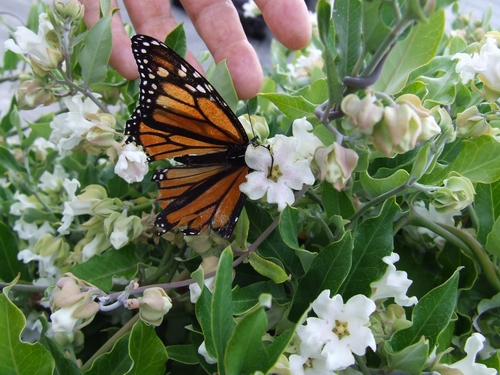 Moth plant is an example of a serious pest plant that's classed as an "unwanted organism". Butterflies, moths and bees are attracted to its flowers and become trapped.
Moth plant is an example of a serious pest plant that's classed as an "unwanted organism". Butterflies, moths and bees are attracted to its flowers and become trapped.
Northland Regional Council's role and policies
Under the Biosecurity Act, the regional council is responsible for managing pest plants in Northland, apart from nine plants which are considered nationally important. The responsibility for the control of these nine National Interest Pest Response (NIPR) plants rests with the Ministry for Primary Industries. Four of the nine NIPR plants - cape tulip, Manchurian wild rice, salvinia and water hyacinth - are present in Northland.
The council develops its own strategies for other pest plants that are a problem in Northland. The Act requires weeds to be assessed for the impact they have economically, environmentally and culturally (Māori).
Eighty plants are considered serious enough for inclusion in Northland’s pest management plan. Some of these pest plants are:
- African feather grass
- aquatic weeds (ten species)
- Bathurst bur
- forest invader plants (61 species)
- gorse
- lantana
- Manchurian rice grass (also known as Manchurian wild grass)
- nassella tussock
- privet
- spartina, and
- wild ginger.
Check out the pest plants in our Pest Control Hub
Weed Control
The regional council varies its approach to weed control depending on the species of weed, where it is growing and how it is spreading. If it is one of the most serious weeds, the council’s biosecurity officers will be called in to remove the problem plants at no cost to the owner. Land owners may be required to keep other serious weeds under control and away from boundaries to reduce the chance of spread. The council carries out control work for plants that are at very low levels of infestation and also checks garden centres to make sure they are not selling any plants that are banned from sale in New Zealand.
Why should you care?
Weeds matter because they are changing the natural balance of plants, animals and insects in Northland. Many of Northland's native plants and animals cannot be found anywhere else in the world and many of them are now endangered.
You won't have to look far to find some weeds to study. Check the roadside outside your school or home, around the school property or in a patch of nearby bush.
How do weeds spread?
Most weeds are spread by seed. Birds eat the fleshy berries with the seed inside and carry them in their stomachs when they fly away. This is how weeds have been deposited on many of Northland's coastal islands. Seeds can also be carried in the wind in floating pods, or by being ejected by such things as gorse pods popping open. Other seeds have hooks or burs that are caught in the coats of animals.
Some weeds send up new plants from rhizomes that spread underground. These form dense clumps that tend to choke out other more desirable plants. Some are creepers, which grow over the top of other plants and trees and choke them.
Some weeds are difficult to eradicate because new plants can grow from any piece of the plant that is broken off. The most successful weeds use a combination of different methods to spread into new areas.
 These kūkupa (wood pigeons) feeding on the berries of a bangalow palm will spread the seeds of this tree, that is a potential future weed.
These kūkupa (wood pigeons) feeding on the berries of a bangalow palm will spread the seeds of this tree, that is a potential future weed.
Weeds on farms
There are hundreds of weeds growing on farms in Northland and the most serious kinds threaten to invade or take over productive land, or land which has important ecological or cultural values. Weeds thrive in Northland's warm climate and soils. They are more likely to become established on land that is disturbed often, such as quarry sites, roadsides and erosion spots.
Weeds in water
Aquatic weeds are like stealthy invaders because they spread quickly to occupy the available space in water bodies in a very short time. They include alligator weed, hornwort, oxygen weeds and parrot's feather. They all reproduce rapidly from pieces that break off and form floating mats. Some, live partly in the water and partly on the land.
One of the worst aquatic weeds in Northland is Manchurian wild rice (Zizania latifolia), which arrived accidentally in ship’s ballast water near Dargaville more than 100 years ago.
Manchurian wild rice has now spread far and wide in the Northern Wairoa River and its tributaries. The tall grass, which originally comes from China, Japan and Korea, forms dense mats and has deep roots and thick rhizomes (underground stems) which spread widely. It is considered a major plant pest because it completely takes over all other vegetation, blocking drainage in waterways and destroying stopbanks with its deep roots. It also wrecks native plant and fish habitats, and is extremely difficult to eradicate because any root or rhizome fragments can regrow.
The Northland Regional Pest Management Plan for Manchurian wild rice prohibits distribution or sale of the plant and advocates working with landowners and contractors to prevent the spread of the grass through dirty machinery.
 Manchurian wild rice growing thick and tall along the Northern Wairoa River.
Manchurian wild rice growing thick and tall along the Northern Wairoa River.
Weeds in bush
Northland's forests are special because of their unique native species. Bush invaders such as wild ginger are a serious threat because they can take over the habitat of rare and endangered species, prevent native seedlings growing and reduce the diversity of plants.
There are two species of wild ginger that cause problems in Northland. The most common is kahili ginger (Hedychium gardnerianum). Yellow ginger (Hedychium flavescens), is the other.
The strikingly beautiful large yellow flowers with red stamens make kahili ginger easy to spot on roadsides and in bush areas when they flower between January and March. Yellow ginger flowers later, between April and July, and its flowers are creamy yellow.
Both types of wild ginger can form thick infestations, taking over every other type of vegetation. The rhizomes form dense beds up to one metre deep. All thick rhizomes of the wild ginger plants can regrow, making it difficult to eradicate. Small infestations can be dug out and the rhizomes smashed up or deeply buried. Kahili ginger seeds are carried long distances by birds, creating new infestations. Yellow ginger does not produce fruit or seed in New Zealand, but it can still take over areas in which it is growing.
The Regional Pest Management Plan for wild ginger includes banning these plants from sale, propagation or distribution.
 Our Biosecurity Manager is dwarfed by invasive wild ginger. Can you see him?
Our Biosecurity Manager is dwarfed by invasive wild ginger. Can you see him?
Eradication plants
These plants are considered very serious to our environmental safety. If they are found in Northland, the regional council will remove them at no cost to the landowner.
If you see one of these eradication plants, look it up in our Pest Control Hub and report your sighting to us.
Akebia (chocolate vine)
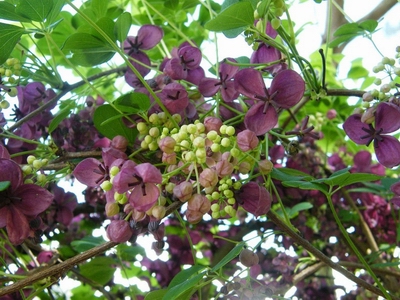
This plant is a twining vine or ground cover found in open to semi-shaded sites along forest margins where it out-competes all other vegetation. Purple flowers from August to October smell like chocolate or vanilla.
Balloon vine
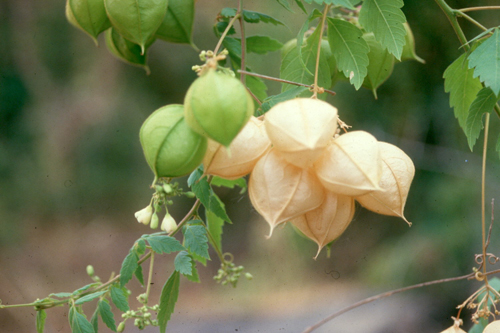
This vigorous climbing vine prefers moist river edges and forest margins but can grow anywhere. It has small white flowers and balloon-like papery seed pods and hard black seeds. It out-competes and smothers native plants.
Batwing passionflower
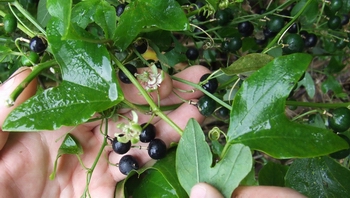
This shade-tolerant vine can grow in a variety of locations. It is very invasive, and can smother, shade and strangle the vegetation it grows on. It has distinctive bat-wing shaped leaves, small yellow or light-green coloured flowers and small black berries. Infestations are known to exist in and around Kerikeri, Kaitaia, Mangonui, Waikare Inlet, Kamo, and Whau Valley.
Cape tulip
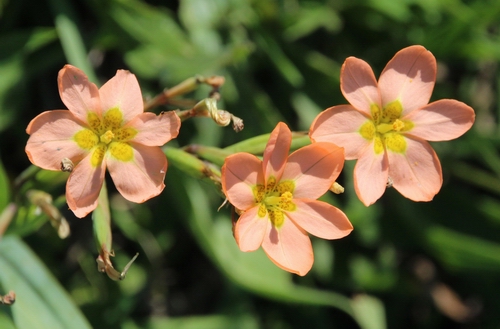
Cape tulip is a perennial herb that grows best in open environments, such as grasslands and pasture. It has the potential to establish dense colonies over wide areas of pasture, and could have a serious economic impact on agriculture if widely established. It produces shoots in winter, and dies back in early summer. Flowers are six-petalled and usually salmon-pink.
Cathedral bells

Cathedral bells is a fast-growing evergreen vine that can grow to six metres tall. It climbs over trees and shrubs, forming a dense canopy that smothers them. It usually has three pairs of oval leaflets with twining tendrils growing from the midrib, and green bell-shaped flowers that turn purple as they mature. Its 'fruit' are hard, oval capsules that split to release numerous winged seeds.
Chilean rhubarb

Chilean rhubarb is a giant, rhubarb-like herb with huge prickly leaves that can reach up to 2.5 metres tall. It likes damp sites on wetland and riparian margins, coastal cliffs, moist banks and disturbed sites. It produces abundant fruit, which are dispersed by birds, and forms dense patches that exclude virtually all other plants. In winter it dies back to large creeping stems and large, sausage-like flower spikes that are up to one metre tall. The spikes are covered in little flowers that are followed by tiny orange fruits.
Evergreen buckthorn (Italian buckthorn)
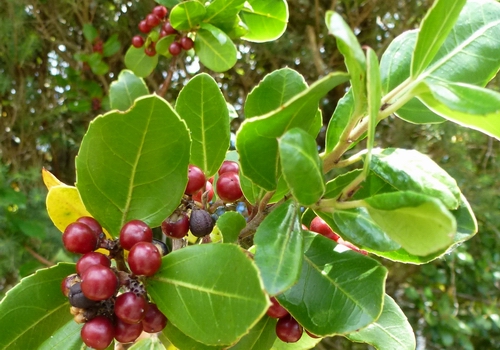
This evergreen shrub or tree tolerates a wide range of conditions. It forms dense stands and develops a dense leafy canopy under which no other plants can grow. It can grow to five metres tall, but may become a stunted shrub in exposed sites. It has distinctive purplish shoots and glossy berries which ripen from dark-red to black from December to January.
Field horsetail
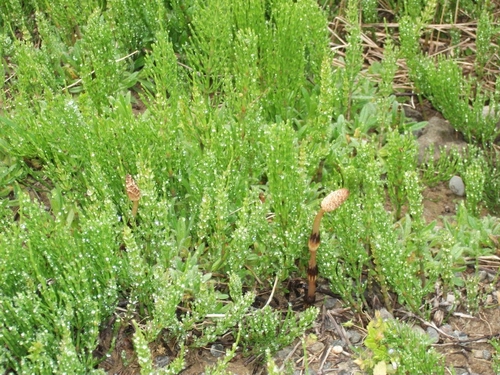
Field horsetail is an erect, primitive fern-ally that grows up to 80 centimetres high in a range of habitats. This aggressive weed forms extensive colonies which are difficult to kill. It produces fertile stems that appear in spring and die back in summer, and infertile stems that resemble miniature pine trees. It dies back in winter to a deep, branching root system with round tubers.
Firethorn
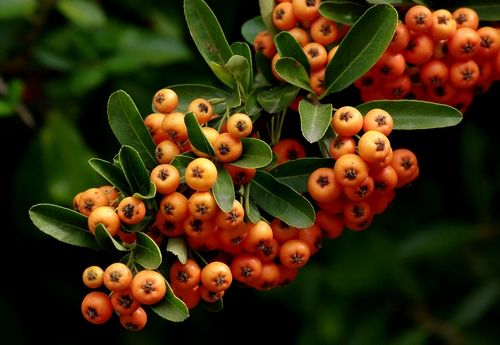
Firethorn is a large spiny shrub growing 2-5 metres tall and up to five metres across. It can form dense stands, out-competing native species and restricting access to grazing by domestic and wild animals. It has hairy stems, shiny dark green leaves with undersides that are hairy and whitish, and white flowers in dense clusters. Its small berry-like fruit turn yellow or orange when ripe.
Gypsywort
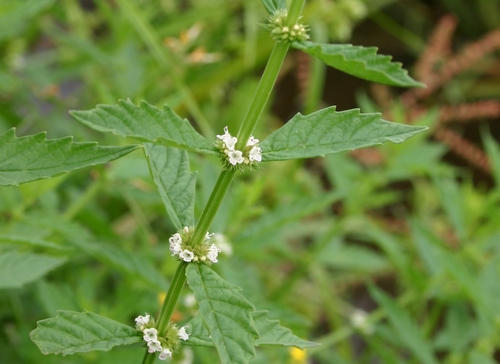
Gypsywort is a perennial herb up to about one metre tall. It lacks the characteristic minty smell of similar species. Flowers occur in summer-autumn and are small, white to pale pink/purple. This pest plant mainly occurs in the margins of lakes, rivers, ponds and other water bodies, in drainage ditches, damp pasture and waste land. Gypsywort is invasive in Waikato and overseas. It can spread rapidly via water movement followed by localised vegetative spread. It is presumed to displace native vegetation, but this and other potential biodiversity impacts are data deficient.
Lesser knotweed
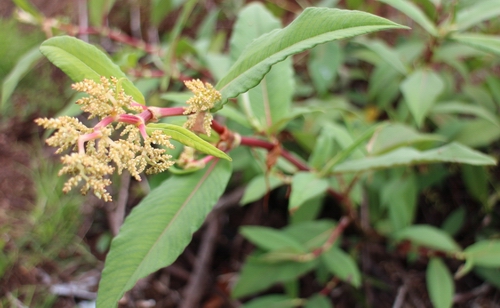
Lesser knotweed is a perennial herb that can grow to one metre tall. Little is known about potential impacts in New Zealand, but in Britain it is a vigorous coloniser that grows in dense patches and suppresses other plants. It has hairy leaves and bunches of white or pink flowers. Lesser knotweed spreads readily from rhizome (root) fragments.
Mexican feather grass

Mexican feather grass is a densely tufted, perennial tussock grass that grows up to 70 centimetres tall and prefers a dry, temperate climate. This invader crowds out pasture species and reduces productivity because it has no grazing value. Native species can also be replaced in open and coastal areas. Its feathery flower head appears between October and December.
Mickey Mouse plant (bird’s eye bush)

Mickey Mouse plant is a 1-2 metres tall shrub found in gardens, derelict building sites and the under-storey and edges of forest. It can form a dense monoculture that prevents regeneration of native species. It is easily dispersed, and could spread from urban areas to other habitats. Its black berry-like fruits are attached to red sepals, resembling the face of Mickey Mouse.
Monkey musk
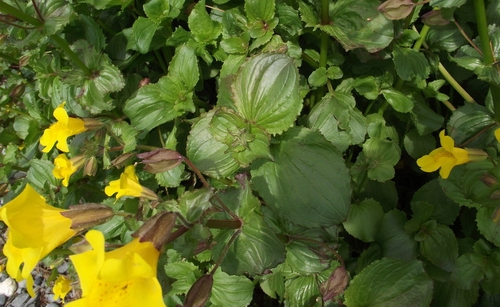
Monkey musk is a soft herb that grows up to 60 centimetres tall, forming bright-green leafy clumps or large masses. It has yellow flowers with red spots on the bearded lower lip. This wetland plant grows along freshwater margins but it can also grow partially submerged in water. It will also occur on damp, disturbed ground away from wetlands. Monkey musk can out-compete native plants and has the potential to choke channels and impede drainage. Due to its relatively high light demand, it is out-competed by taller perennial or woody plants.
Nassella tussock
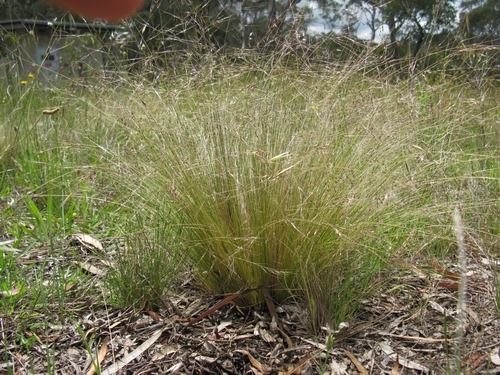
Nassella tussock is a perennial tussock-forming grass found in dry farmland. It can form dense stands in low-growing plant communities such as pasture, preventing other species from establishing, and making large areas incapable of supporting livestock. It grows up to one metre high and has fine-bladed, wiry leaves. Drooping seed heads have a purplish tinge.
Nutgrass
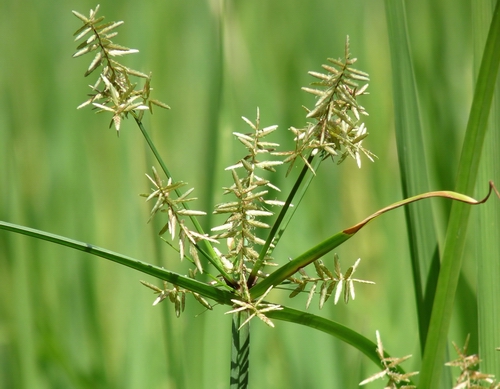
Nutgrass is a grass-like perennial that grows to about 30 centimetres high. It has been described as one of the world's worst weeds based on its distribution and effect on crops. Nutgrass will compete with other plants for ground resources and its roots release substances into the soil that can be harmful to other plants. Its roots are nut-shaped and are the main way in which it spreads.
Royal fern
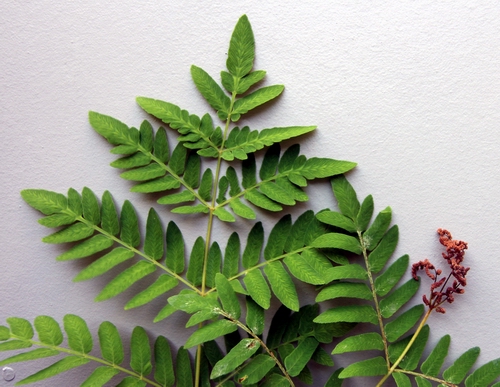
Royal fern is a deciduous fern that has large, feather-like fronds up to three metres long and five centimetres wide. Separate fertile fronds are brown and resemble tiny bunches of grapes. A short woody trunk grows up to 1.5 metres high and plants die back to the woody trunk in winter. Royal fern grows in wet, peaty habitats, roadside drains and occasionally on clay banks next to water bodies. It can naturalise and form dense colonies in a range of wetland habitats, especially in disturbed areas and under the shade of willows or manuka. The plants displace other small native wetland plants.
Spartina
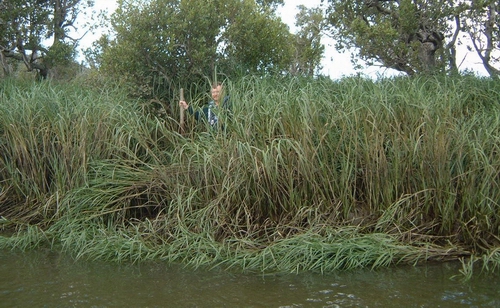
Spartina is an estuarine grass that grows in clumps up to 1.5 metres tall. It is an aggressive and persistent invader of inter-tidal mudflats, leading to a loss of habitat for birds and fish, surface flooding on adjacent land, and trapped sediment that raises ground levels. Spartina alterniflora is the most common spartina species in Northland.
Salvinia (Karba weed)
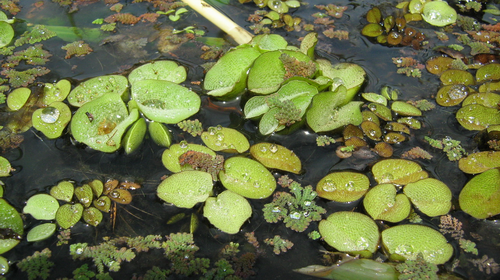
Salvinia is a free-floating aquatic fern. With its hairy leaves and floating habit, it can be hard to recognise as a fern. Salvinia quickly forms extensive mats, completely smothering waterways, excluding native plants, impeding drainage, disrupting recreational activities and reducing water quality by lowering oxygen levels. Salvinia is a Notifiable Organism (Biosecurity (Notifiable Organisms) Order 2010) and is part of the National Interest Pests Response (NIPR). Management of this pest plant is led by the Ministry for Primary Industries.
Senegal tea (temple plant, costata)
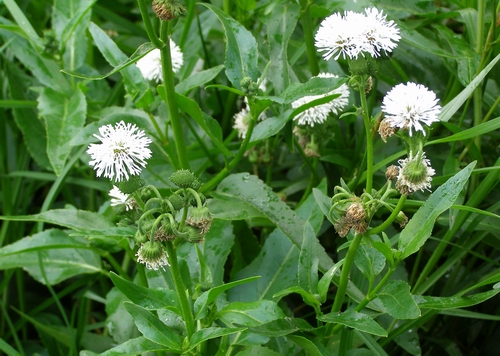
This perennial herb grows to 1.5 metres high in marshland or water. It has pointed leaves with wavy margins, and distinctive, fluffy white flowers. The plant looks like alligator weed and is extremely rare in Northland. It invades damp ground and still or slow-moving water where it forms floating mats. It is poisonous and induces allergic reactions.
Water hyacinth
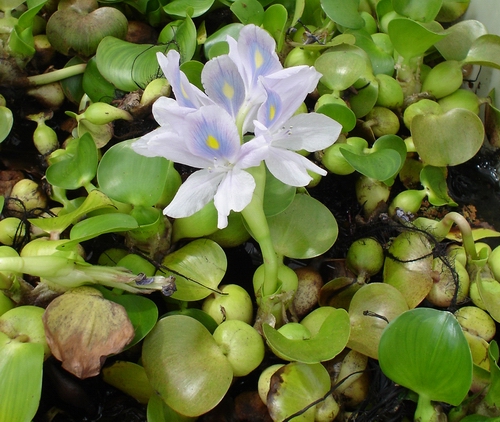
Water hyacinth is a free-floating plant that has glossy green leaves with spongy leaf stems that act like floats. It produces a spike of up to 10 large, lilac-mauve flowers. Water hyacinth
grows in still or slow-moving freshwater, forming dense mats which can completely smother waterways, reduce water quality, exclude native plants, impede drainage and disrupt recreational activities. Water hyacinth is a Notifiable Organism (Biosecurity (Notifiable Organisms) Order 2010) and is part of the National Interest Pests Response (NIPR). Management of this pest plant is led by the Ministry for Primary Industries.
Wilding kiwifruit
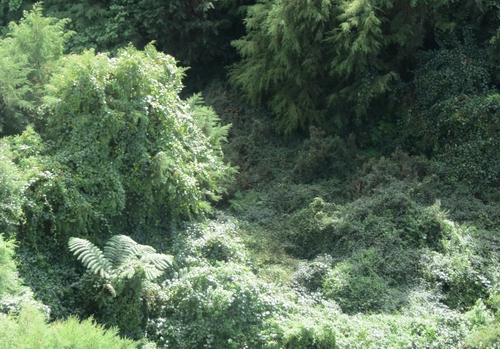
Kiwifruit is a vigorous vine that is cultivated for its fruit. The entire plant is hairy with oval leaves and reddish leaf stem. Wilding kiwifruit can grow in a wide variety of habitats including scrub, gullies, stands of native bush and pine plantations. Wild kiwifruit vines can grow more than 20 metres up into the forest canopy and are also very long-lived, out-competing native seedlings and smothering growth. Wilding kiwifruit are a vector for PSA (Pseudomonassyringaepv actinidiae).
Yellow flag iris
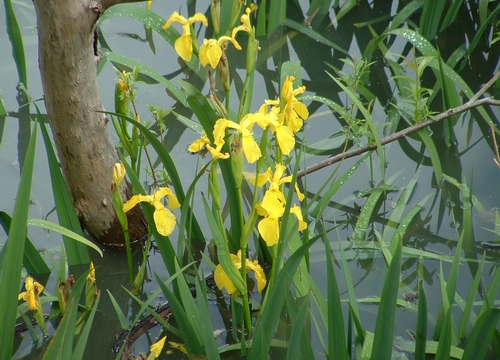
Yellow flag iris grows as leafy clumps up to two metres tall. It has sword-like leaves and produces pale-yellow to golden-orange flowers from October to December followed by seed capsules containing many disc-like seeds. Yellow flag iris is a fast-growing and fast-spreading invasive plant that can out-compete other plants, forming almost impenetrable thickets as it over-tops and replaces native species. It can also grow out across the water, forming floating mats that are strong enough to support the weight of a person. It is poisonous to grazing animals.
Managing the weed invasion
The regional council uses a multi-faceted approach when working with Northlanders to combat pest plants and stop them spreading. Education and advice to the public, incentives such as supporting Landcare groups, rules for property owners and undertaking control work, are all part of our strategy for pest plant control.
Spray and manual control
Using machines and labourers to cut down and stump, treat or remove the plants can control some pest plants. However, cutting often doesn't kill plants and in some cases may make them grow faster. Sometimes spraying is needed in awkward spots or when the infestation is too large or difficult to be reached by labourers. Regional council staff can help with advice on the best methods to use. Some weeds respond best to control at certain times of the year. Spraying or cutting back at other times of the year might not work as well and result in wasted spray, money and effort.
Biological controls
Our biosecurity officers can offer advice on biological controls. Biological control uses one organism or a group of organisms (usually insects or fungi) to control another. Biological control agents will never completely eradicate a pest plant, but they can stop a weed from spreading and reduce infestations to a manageable level. Biological control agents are initially released in trial sites around the region. Once they become established, they are distributed freely to landowners although often the insects are successful in spreading around the region by themselves.
Sometimes scientists introduce a range of different biological control agents to target the same pest plant. An example would be the five agents that have been imported to target one of New Zealand's worst pest plants - gorse. They are the gorse spider mite, gorse thrip, gorse seed weevil, gorse pod moth and colonial hard shoot moth.
Gorse spider mite
Tiny gorse spider mites live in webs on a gorse bush and are spread with the wind. They can cause considerable damage to gorse plants if they reach large numbers on a bush. Gorse spider mites come from Europe and were first imported in 1988. They did not do well in Northland, so scientists found other spider mites from Spain and Portugal which have been more successful and are now established throughout all regions of New Zealand.
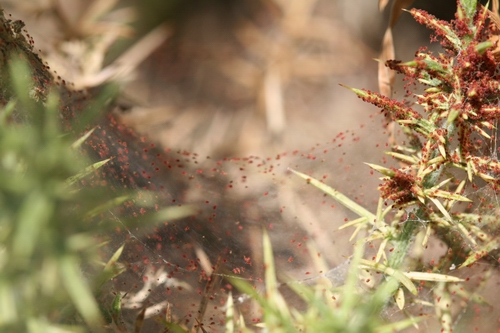 Gorse spider mites have sucking mouths that pierce the outer layer of the gorse foliage and extract the cells.
Gorse spider mites have sucking mouths that pierce the outer layer of the gorse foliage and extract the cells.
Gorse thrips
Gorse thrips spread by walking or blowing on to neighbouring bushes. The tiny insects tend to stay in one place and infestations can take years to move only a few metres. If a bush becomes overpopulated, gorse thrips can occasionally produce winged offspring that fly away and start new colonies.
Gorse seed weevil
These insects come from Europe and were one of the first biological control agents to be introduced to New Zealand, having been imported between 1931 and 1946.
They are tiny - between 1.8mm and 2.5mm long - and chew small holes in the walls of seedpods where they lay their eggs. When the larvae hatch after about a month, they feed on and destroy the gorse seeds in the pods. They are very successful but can only kill gorse seeds in spring and summer.
Gorse pod moth
These little moths were brought in to attack gorse seeds when the gorse seed weevils could not. From Europe originally, they lay shiny white eggs hidden in gorse flowers. After about two weeks the caterpillars hatch out and chew their way into the pods. Once a pod moth caterpillar has eaten all the seeds inside a pod it will burrow back out again and find a new pod.
Colonial hard shoot moth
A newcomer to the battle against gorse is the colonial hard shoot moth, which biosecurity officers hope will become established so colonies can be introduced throughout Northland.
Future weeds
Bangalow palm
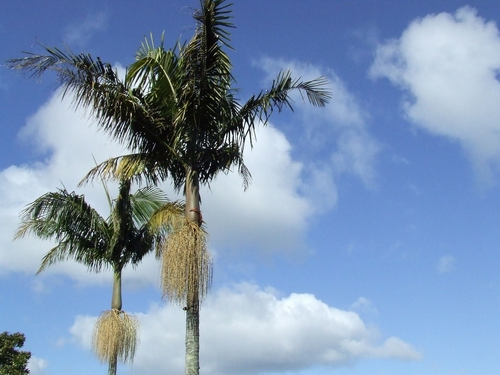
There are many plants that have the potential to become pest plants in Northland and many of these are on the verge of that classification already.
These include bangalow palms, which are becoming a plant pest in many areas.
Other weeds could arrive by gardeners bringing in plant matter illegally.
Hundreds of different plant varieties are imported legally every year by gardeners and garden centres. They have to go through a strict process to be allowed to bring the plants into New Zealand.
How can you help?
- If you find any of the pest plants featured here, remove them and dispose of them carefully. You can get advice from our Pest Control Hub, pick up a regional council pamphlet on the weed, or ask for our help if you’re not sure what to do.
- Many weeds have spread when people throw away their garden waste instead of composting, burying or mulching problem plants. Take your pest plants to a composting depot or landfill, especially those that can grow from fragments.
- Adopt a piece of bush and monitor the weeds that grow there. Some of the lush greenery may be weeds that are choking the native plants.
- Get a group of people together for weed-clearing working bees. Learn to identify weeds and the best way to get rid of them properly.
- Pull out a few weeds each time you walk through bush or along the roadside.
- Join a Landcare group, or form a new one if there is none in your area. Contact the Northland Regional Council or the New Zealand Landcare Trust for details.
- If you find patches of ginger, snip the flower heads off before they go to seed. Pull very small seedlings out of the ground making sure that the entire plant is removed.
Sources: NRC staff, The Biological Control of Weeds Book, Northland Regional Pest Management Strategies, NRC Unwanted Plants - the Dirty Dozen pamphlet, NRC Environmental Weeds - Delightful but Destructive pamphlet, NRC Pest facts pamphlets.
